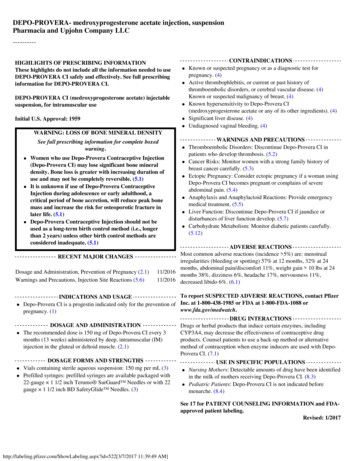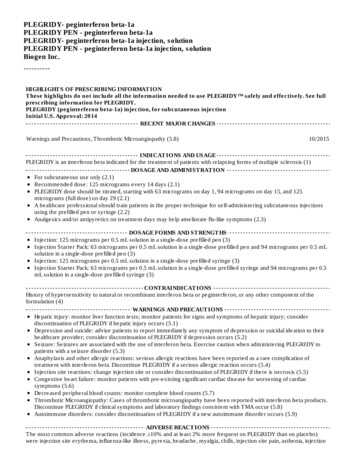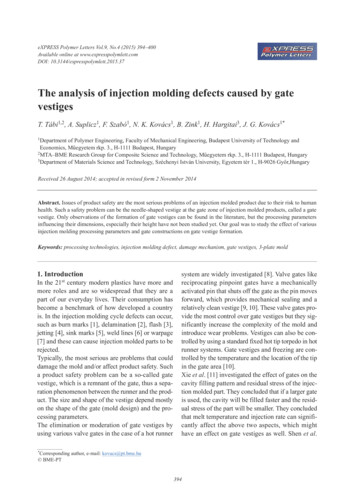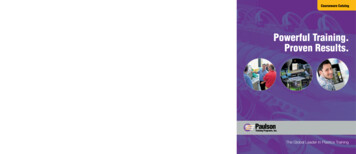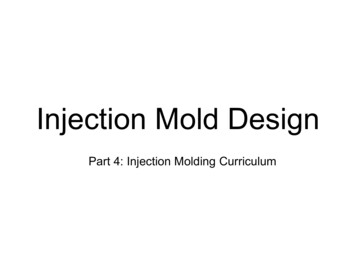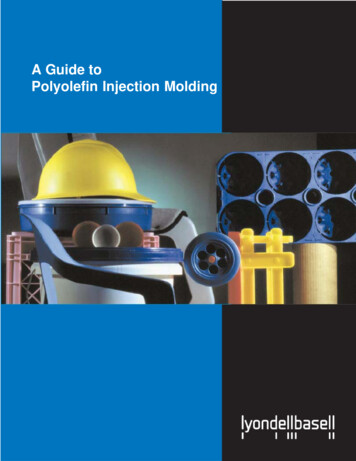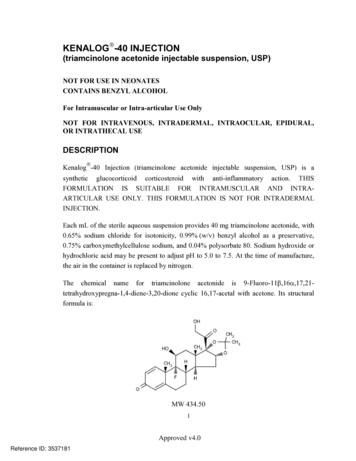
Transcription
KENALOG -40 INJECTION(triamcinolone acetonide injectable suspension, USP)NOT FOR USE IN NEONATESCONTAINS BENZYL ALCOHOLFor Intramuscular or Intra-articular Use OnlyNOT FOR INTRAVENOUS, INTRADERMAL, INTRAOCULAR, EPIDURAL,OR INTRATHECAL USEDESCRIPTION Kenalog -40 Injection (triamcinolone acetonide injectable suspension, USP) is asynthetic glucocorticoid corticosteroid with anti-inflammatory action. THISFORMULATION IS SUITABLE FOR INTRAMUSCULAR AND INTRAARTICULAR USE ONLY. THIS FORMULATION IS NOT FOR INTRADERMALINJECTION.Each mL of the sterile aqueous suspension provides 40 mg triamcinolone acetonide, with0.65% sodium chloride for isotonicity, 0.99% (w/v) benzyl alcohol as a preservative,0.75% carboxymethylcellulose sodium, and 0.04% polysorbate 80. Sodium hydroxide orhydrochloric acid may be present to adjust pH to 5.0 to 7.5. At the time of manufacture,the air in the container is replaced by nitrogen.The chemical name for triamcinolone acetonide is 9-Fluoro-11 ,16 ,17,21tetrahydroxypregna-1,4-diene-3,20-dione cyclic 16,17-acetal with acetone. Its structuralformula is:MW 434.501Approved v4.0Reference ID: 3537181
Triamcinolone acetonide occurs as a white to cream-colored, crystalline powder havingnot more than a slight odor and is practically insoluble in water and very soluble inalcohol.CLINICAL PHARMACOLOGYGlucocorticoids, naturally occurring and synthetic, are adrenocortical steroids that arereadily absorbed from the gastrointestinal tract.Naturally occurring glucocorticoids (hydrocortisone and cortisone), which also have saltretaining properties, are used as replacement therapy in adrenocortical deficiency states.Synthetic analogs such as triamcinolone are primarily used for their anti-inflammatoryeffects in disorders of many organ systems.Kenalog-40 Injection has an extended duration of effect which may be sustained over aperiod of several weeks. Studies indicate that following a single intramuscular dose of60 mg to 100 mg of triamcinolone acetonide, adrenal suppression occurs within 24 to 48hours and then gradually returns to normal, usually in 30 to 40 days. This findingcorrelates closely with the extended duration of therapeutic action achieved with thedrug.INDICATIONS AND USAGEIntramuscularWhere oral therapy is not feasible, injectable corticosteroid therapy, includingKenalog-40 Injection (triamcinolone acetonide injectable suspension, USP) is indicatedfor intramuscular use as follows:Allergic states: Control of severe or incapacitating allergic conditions intractable toadequate trials of conventional treatment in asthma, atopic dermatitis, contact dermatitis,drug hypersensitivity reactions, perennial or seasonal allergic rhinitis, serum sickness,transfusion reactions.Dermatologic diseases: Bullous dermatitis herpetiformis, exfoliative erythroderma,mycosis fungoides, pemphigus, severe erythema multiforme (Stevens-Johnsonsyndrome).2Approved v4.0Reference ID: 3537181
Endocrine disorders: Primary or secondary adrenocortical insufficiency (hydrocortisoneor cortisone is the drug of choice; synthetic analogs may be used in conjunction withmineralocorticoids where applicable; in infancy, mineralocorticoid supplementation is ofparticular importance), congenital adrenal hyperplasia, hypercalcemia associated withcancer, nonsuppurative thyroiditis.Gastrointestinal diseases: To tide the patient over a critical period of the disease inregional enteritis and ulcerative colitis.Hematologic disorders: Acquired (autoimmune) hemolytic anemia, Diamond-Blackfananemia, pure red cell aplasia, selected cases of secondary thrombocytopenia.Miscellaneous: Trichinosis with neurologic or myocardial involvement, tuberculousmeningitis with subarachnoid block or impending block when used with appropriateantituberculous chemotherapy.Neoplastic diseases: For the palliative management of leukemias and lymphomas.Nervous system: Acute exacerbations of multiple sclerosis; cerebral edema associatedwith primary or metastatic brain tumor or craniotomy.Ophthalmic diseases: Sympathetic ophthalmia, temporal arteritis, uveitis, and ocularinflammatory conditions unresponsive to topical corticosteroids.Renal diseases: To induce diuresis or remission of proteinuria in idiopathic nephroticsyndrome or that due to lupus erythematosus.Respiratory diseases: Berylliosis, fulminating or disseminated pulmonary tuberculosiswhen used concurrently with appropriate antituberculous chemotherapy, idiopathiceosinophilic pneumonias, symptomatic sarcoidosis.Rheumatic disorders: As adjunctive therapy for short-term administration (to tide thepatient over an acute episode or exacerbation) in acute gouty arthritis; acute rheumaticcarditis; ankylosing spondylitis; psoriatic arthritis; rheumatoid arthritis, includingjuvenile rheumatoid arthritis (selected cases may require low-dose maintenance therapy).For the treatment of dermatomyositis, polymyositis, and systemic lupus erythematosus.3Approved v4.0Reference ID: 3537181
Intra-ArticularThe intra-articular or soft tissue administration of Kenalog-40 Injection is indicatedas adjunctive therapy for short-term administration (to tide the patient over an acuteepisode or exacerbation) in acute gouty arthritis, acute and subacute bursitis, acutenonspecific tenosynovitis, epicondylitis, rheumatoid arthritis, synovitis, or osteoarthritis.CONTRAINDICATIONSKenalog-40 Injection is contraindicated in patients who are hypersensitive to anycomponents of this product (see WARNINGS: General).Intramuscular corticosteroidthrombocytopenic cWARNINGSSerious Neurologic Adverse Reactions with EpiduralAdministrationSerious neurologic events, some resulting in death, have been reported with epiduralinjection of corticosteroids (see WARNINGS: Neurologic). Specific events reportedinclude, but are not limited to, spinal cord infarction, paraplegia, quadriplegia, corticalblindness, and stroke. These serious neurologic events have been reported with andwithout use of fluoroscopy. The safety and effectiveness of epidural administration ofcorticosteroids have not been established, and corticosteroids are not approved for thisuse.GeneralExposure to excessive amounts of benzyl alcohol has been associated with toxicity(hypotension, metabolic acidosis), particularly in neonates, and an increased incidence ofkernicterus, particularly in small preterm infants. There have been rare reports of deaths,primarily in preterm infants, associated with exposure to excessive amounts of benzylalcohol. The amount of benzyl alcohol from medications is usually considered negligiblecompared to that received in flush solutions containing benzyl alcohol. Administration ofhigh dosages of medications containing this preservative must take into account the totalamount of benzyl alcohol administered. The amount of benzyl alcohol at which toxicitymay occur is not known. If the patient requires more than the recommended dosages or4Approved v4.0Reference ID: 3537181
other medications containing this preservative, the practitioner must consider the dailymetabolic load of benzyl alcohol from these combined sources (see PRECAUTIONS:Pediatric Use).Rare instances of anaphylaxis have occurred in patients receiving corticosteroid therapy(see ADVERSE REACTIONS). Cases of serious anaphylaxis, including death, havebeen reported in individuals receiving triamcinolone acetonide injection, regardless of theroute of administration.Because Kenalog-40 Injection (triamcinolone acetonide injectable suspension, USP) is asuspension, it should not be administered intravenously.Unless a deep intramuscular injection is given, local atrophy is likely to occur. (Forrecommendations on injection techniques, see DOSAGE AND ADMINISTRATION.)Due to the significantly higher incidence of local atrophy when the material is injectedinto the deltoid area, this injection site should be avoided in favor of the gluteal area.Increased dosage of rapidly acting corticosteroids is indicated in patients oncorticosteroid therapy subjected to any unusual stress before, during, and after thestressful situation. Kenalog-40 Injection is a long-acting preparation, and is not suitablefor use in acute stress situations. To avoid drug-induced adrenal insufficiency, supportivedosage may be required in times of stress (such as trauma, surgery, or severe illness) bothduring treatment with Kenalog-40 Injection and for a year afterwards.Results from one multicenter, randomized, placebo-controlled study withmethylprednisolone hemisuccinate, an intravenous corticosteroid, showed an increase inearly (at 2 weeks) and late (at 6 months) mortality in patients with cranial trauma whowere determined not to have other clear indications for corticosteroid treatment. Highdoses of systemic corticosteroids, including Kenalog-40 Injection, should not be used forthe treatment of traumatic brain injury.Cardio-RenalAverage and large doses of corticosteroids can cause elevation of blood pressure, salt andwater retention, and increased excretion of potassium. These effects are less likely tooccur with the synthetic derivatives except when they are used in large doses. Dietary saltrestriction and potassium supplementation may be necessary (see PRECAUTIONS). Allcorticosteroids increase calcium excretion.5Approved v4.0Reference ID: 3537181
Literature reports suggest an apparent association between use of corticosteroids and leftventricular free wall rupture after a recent myocardial infarction; therefore, therapy withcorticosteroids should be used with great caution in these patients.EndocrineCorticosteroids can produce reversible hypothalamic-pituitary-adrenal (HPA) axissuppression with the potential for glucocorticosteroid insufficiency after withdrawal oftreatment.Metabolic clearance of corticosteroids is decreased in hypothyroid patients and increasedin hyperthyroid patients. Changes in thyroid status of the patient may necessitateadjustment in dosage.InfectionsGeneralPatients who are on corticosteroids are more susceptible to infections than are healthyindividuals. There may be decreased resistance and inability to localize infection whencorticosteroids are used. Infection with any pathogen (viral, bacterial, fungal, protozoan,or helminthic) in any location of the body may be associated with the use ofcorticosteroids alone or in combination with other immunosuppressive agents. Theseinfections may be mild to severe. With increasing doses of corticosteroids, the rate ofoccurrence of infectious complications increases. Corticosteroids may also mask somesigns of current infection.Fungal InfectionsCorticosteroids may exacerbate systemic fungal infections and therefore should not beused in the presence of such infections unless they are needed to control drug reactions.There have been cases reported in which concomitant use of amphotericin B andhydrocortisone was followed by cardiac enlargement and congestive heart failure (seePRECAUTIONS: Drug Interactions: Amphotericin B injection and potassiumdepleting agents).6Approved v4.0Reference ID: 3537181
Special PathogensLatent disease may be activated or there may be an exacerbation of intercurrent infectionsdue to pathogens, including those caused by Amoeba, Candida, Cryptococcus,Mycobacterium, Nocardia, Pneumocystis, or Toxoplasma.It is recommended that latent amebiasis or active amebiasis be ruled out before initiatingcorticosteroid therapy in any patient who has spent time in the tropics or in any patientwith unexplained diarrhea.Similarly, corticosteroids should be used with great care in patients with known orsuspected Strongyloides (threadworm) infestation. In such patients, corticosteroidinduced immunosuppression may lead to Strongyloides hyperinfection and disseminationwith widespread larval migration, often accompanied by severe enterocolitis andpotentially fatal gram-negative septicemia.Corticosteroids should not be used in cerebral malaria.TuberculosisThe use of corticosteroids in patients with active tuberculosis should be restricted to thosecases of fulminating or disseminated tuberculosis in which the corticosteroid is used forthe management of the disease in conjunction with an appropriate anti-tuberculosisregimen. If corticosteroids are indicated in patients with latent tuberculosis or tuberculinreactivity, close observation is necessary as reactivation of the disease may occur. Duringprolonged corticosteroid therapy, these patients should receive chemoprophylaxis.VaccinationAdministration of live or live, attenuated vaccines is contraindicated in patientsreceiving immunosuppressive doses of corticosteroids. Killed or inactivated vaccinesmay be administered. However, the response to such vaccines cannot be predicted.Immunization procedures may be undertaken in patients who are receivingcorticosteroids as replacement therapy, eg, for Addison’s disease.Viral InfectionsChicken pox and measles can have a more serious or even fatal course in pediatric andadult patients on corticosteroids. In pediatric and adult patients who have not had thesediseases, particular care should be taken to avoid exposure. The contribution of the7Approved v4.0Reference ID: 3537181
underlying disease and/or prior corticosteroid treatment to the risk is also not known. Ifexposed to chicken pox, prophylaxis with varicella zoster immune globulin (VZIG) maybe indicated. If exposed to measles, prophylaxis with immunoglobulin (IG) may beindicated. (See the respective package inserts for complete VZIG and IG prescribinginformation.) If chicken pox develops, treatment with antiviral agents should beconsidered.NeurologicEpidural and intrathecal administration of this product is not recommended. Reports ofserious medical events, including death, have been associated with epidural andintrathecal routes of corticosteroid administration (see ADVERSE REACTIONS:Gastrointestinal and Neurologic/Psychiatric).OphthalmicUse of corticosteroids may produce posterior subcapsular cataracts, glaucoma withpossible damage to the optic nerves, and may enhance the establishment of secondaryocular infections due to bacteria, fungi, or viruses. The use of oral corticosteroids is notrecommended in the treatment of optic neuritis and may lead to an increase in the risk ofnew episodes. Corticosteroids should not be used in active ocular herpes simplex.Adequate studies to demonstrate the safety of Kenalog Injection use by intraturbinal,subconjunctival, sub-Tenons, retrobulbar, and intraocular (intravitreal) injections havenot been performed. Endophthalmitis, eye inflammation, increased intraocular pressure,and visual disturbances including vision loss have been reported with intravitrealadministration. Administration of Kenalog Injection intraocularly or into the nasalturbinates is not recommended.Intraocular injection of corticosteroid formulations containing benzyl alcohol, such asKenalog Injection, is not recommended because of potential toxicity from the benzylalcohol.PRECAUTIONSGeneralThis product, like many other steroid formulations, is sensitive to heat. Therefore, itshould not be autoclaved when it is desirable to sterilize the exterior of the vial.8Approved v4.0Reference ID: 3537181
The lowest possible dose of corticosteroid should be used to control the condition undertreatment. When reduction in dosage is possible, the reduction should be gradual.Since complications of treatment with glucocorticoids are dependent on the size of thedose and the duration of treatment, a risk/benefit decision must be made in eachindividual case as to dose and duration of treatment and as to whether daily orintermittent therapy should be used.Kaposi’s sarcoma has been reported to occur in patients receiving corticosteroid therapy,most often for chronic conditions. Discontinuation of corticosteroids may result inclinical improvement.Cardio-RenalAs sodium retention with resultant edema and potassium loss may occur in patientsreceiving corticosteroids, these agents should be used with caution in patients withcongestive heart failure, hypertension, or renal insufficiency.EndocrineDrug-induced secondary adrenocortical insufficiency may be minimized by gradualreduction of dosage. This type of relative insufficiency may persist for months afterdiscontinuation of therapy; therefore, in any situation of stress occurring during thatperiod, hormone therapy should be reinstituted. Since mineralocorticoid secretion may beimpaired, salt and/or a mineralocorticoid should be administered concurrently.GastrointestinalSteroids should be used with caution in active or latent peptic ulcers, diverticulitis, freshintestinal anastomoses, and nonspecific ulcerative colitis, since they may increase the riskof a perforation.Signs of peritoneal irritation following gastrointestinal perforation in patients receivingcorticosteroids may be minimal or absent.There is an enhanced effect of corticosteroids in patients with cirrhosis.Intra-Articular and Soft Tissue AdministrationIntra-articularly injected corticosteroids may be systemically absorbed.9Approved v4.0Reference ID: 3537181
Appropriate examination of any joint fluid present is necessary to exclude a septicprocess.A marked increase in pain accompanied by local swelling, further restriction of jointmotion, fever, and malaise are suggestive of septic arthritis. If this complication occursand the diagnosis of sepsis is confirmed, appropriate antimicrobial therapy should beinstituted.Injection of a steroid into an infected site is to be avoided. Local injection of a steroidinto a previously infected joint is not usually recommended.Corticosteroid injection into unstable joints is generally not recommended.Intra-articular injection may result in damage to joint tissues (see ADVERSEREACTIONS: Musculoskeletal).MusculoskeletalCorticosteroids decrease bone formation and increase bone resorption both through theireffect on calcium regulation (ie, decreasing absorption and increasing excretion) andinhibition of osteoblast function. This, together with a decrease in the protein matrix ofthe bone secondary to an increase in protein catabolism, and reduced sex hormoneproduction, may lead to inhibition of bone growth in pediatric patients and thedevelopment of osteoporosis at any age. Special consideration should be given to patientsat increased risk of osteoporosis (ie, postmenopausal women) before initiatingcorticosteroid therapy.Neuro-PsychiatricAlthough controlled clinical trials have shown corticosteroids to be effective in speedingthe resolution of acute exacerbations of multiple sclerosis, they do not show that theyaffect the ultimate outcome or natural history of the disease. The studies do show thatrelatively high doses of corticosteroids are necessary to demonstrate a significant effect.(See DOSAGE AND ADMINISTRATION.)An acute myopathy has been observed with the use of high doses of corticosteroids, mostoften occurring in patients with disorders of neuromuscular transmission (eg, myastheniagravis), or in patients receiving concomitant therapy with neuromuscular blocking drugs(eg, pancuronium). This acute myopathy is generalized, may involve ocular and10Approved v4.0Reference ID: 3537181
respiratory muscles, and may result in quadriparesis. Elevation of creatinine kinase mayoccur. Clinical improvement or recovery after stopping corticosteroids may requireweeks to years.Psychiatric derangements may appear when corticosteroids are used, ranging fromeuphoria, insomnia, mood swings, personality changes, and severe depression to frankpsychotic manifestations. Also, existing emotional instability or psychotic tendenciesmay be aggravated by corticosteroids.OphthalmicIntraocular pressure may become elevated in some individuals. If steroid therapy iscontinued for more than 6 weeks, intraocular pressure should be monitored.Information for PatientsPatients should be warned not to discontinue the use of corticosteroids abruptly orwithout medical supervision, to advise any medical attendants that they are takingcorticosteroids, and to seek medical advice at once should they develop fever or othersigns of infection.Persons who are on corticosteroids should be warned to avoid exposure to chicken pox ormeasles. Patients should also be advised that if they are exposed, medical advice shouldbe sought without delay.Drug InteractionsAminoglutethimide: Aminoglutethimide may lead to a loss of corticosteroid-inducedadrenal suppression.Amphotericin B injection and potassium-depleting agents: When corticosteroids areadministered concomitantly with potassium-depleting agents (ie, amphotericin B,diuretics), patients should be observed closely for development of hypokalemia. Therehave been cases reported in which concomitant use of amphotericin B and hydrocortisonewas followed by cardiac enlargement and congestive heart failure.Antibiotics: Macrolide antibiotics have been reported to cause a significant decrease incorticosteroid clearance.11Approved v4.0Reference ID: 3537181
Anticholinesterases: Concomitant use of anticholinesterase agents and corticosteroidsmay produce severe weakness in patients with myasthenia gravis. If possible,anticholinesterase agents should be withdrawn at least 24 hours before initiatingcorticosteroid therapy.Anticoagulants, oral: Coadministration of corticosteroids and warfarin usually results ininhibition of response to warfarin, although there have been some conflicting reports.Therefore, coagulation indices should be monitored frequently to maintain the desiredanticoagulant effect.Antidiabetics: Because corticosteroids may increase blood glucose concentrations,dosage adjustments of antidiabetic agents may be required.Antitubercular drugs: Serum concentrations of isoniazid may be decreased.Cholestyramine: Cholestyramine may increase the clearance of corticosteroids.Cyclosporine: Increased activity of both cyclosporine and corticosteroids may occurwhen the two are used concurrently. Convulsions have been reported with this concurrentuse.Digitalis glycosides: Patients on digitalis glycosides may be at increased risk ofarrhythmias due to hypokalemia.Estrogens, including oral contraceptives: Estrogens may decrease the hepatic metabolismof certain corticosteroids, thereby increasing their effect.Hepatic enzyme inducers (eg, barbiturates, phenytoin, carbamazepine, rifampin): Drugswhich induce hepatic microsomal drug metabolizing enzyme activity may enhance themetabolism of corticosteroids and require that the dosage of the corticosteroid beincreased.Ketoconazole: Ketoconazole has been reported to decrease the metabolism of certaincorticosteroids by up to 60%, leading to an increased risk of corticosteroid side effects.Nonsteroidal anti-inflammatory drugs (NSAIDs): Concomitant use of aspirin (or othernonsteroidal anti-inflammatory drugs) and corticosteroids increases the risk ofgastrointestinal side effects. Aspirin should be used cautiously in conjunction with12Approved v4.0Reference ID: 3537181
corticosteroids in hypoprothrombinemia. The clearance of salicylates may be increasedwith concurrent use of corticosteroids.Skin tests: Corticosteroids may suppress reactions to skin tests.Vaccines: Patients on prolonged corticosteroid therapy may exhibit a diminishedresponse to toxoids and live or inactivated vaccines due to inhibition of antibodyresponse. Corticosteroids may also potentiate the replication of some organismscontained in live attenuated vaccines. Routine administration of vaccines or toxoidsshould be deferred until corticosteroid therapy is discontinued if possible (seeWARNINGS: Infections: Vaccination).Carcinogenesis, Mutagenesis, Impairment of FertilityNo adequate studies have been conducted in animals to determine whether corticosteroidshave a potential for carcinogenesis or mutagenesis.Steroids may increase or decrease motility and number of spermatozoa in some patients.PregnancyTeratogenic Effects: Pregnancy Category CCorticosteroids have been shown to be teratogenic in many species when given in dosesequivalent to the human dose. Animal studies in which corticosteroids have been given topregnant mice, rats, and rabbits have yielded an increased incidence of cleft palate in theoffspring. There are no adequate and well-controlled studies in pregnant women.Corticosteroids should be used during pregnancy only if the potential benefit justifies thepotential risk to the fetus. Infants born to mothers who have received corticosteroidsduring pregnancy should be carefully observed for signs of hypoadrenalism.Nursing MothersSystemically administered corticosteroids appear in human milk and could suppressgrowth, interfere with endogenous corticosteroid production, or cause other untowardeffects. Caution should be exercised when corticosteroids are administered to a nursingwoman.13Approved v4.0Reference ID: 3537181
Pediatric UseThis product contains benzyl alcohol as a preservative. Benzyl alcohol, a component ofthis product, has been associated with serious adverse events and death, particularly inpediatric patients. The “gasping syndrome” (characterized by central nervous systemdepression, metabolic acidosis, gasping respirations, and high levels of benzyl alcoholand its metabolites found in the blood and urine) has been associated with benzyl alcoholdosages 99 mg/kg/day in neonates and low-birth-weight neonates. Additional symptomsmay include gradual neurological deterioration, seizures, intracranial hemorrhage,hematologic abnormalities, skin breakdown, hepatic and renal failure, hypotension,bradycardia, and cardiovascular collapse. Although normal therapeutic doses of thisproduct deliver amounts of benzyl alcohol that are substantially lower than those reportedin association with the “gasping syndrome,” the minimum amount of benzyl alcohol atwhich toxicity may occur is not known. Premature and low-birth-weight infants, as wellas patients receiving high dosages, may be more likely to develop toxicity. Practitionersadministering this and other medications containing benzyl alcohol should consider thecombined daily metabolic load of benzyl alcohol from all sources.The efficacy and safety of corticosteroids in the pediatric population are based on thewell-established course of effect of corticosteroids which is similar in pediatric and adultpopulations. Published studies provide evidence of efficacy and safety in pediatricpatients for the treatment of nephrotic syndrome ( 2 years of age), and aggressivelymphomas and leukemias ( 1 month of age). Other indications for pediatric use ofcorticosteroids, eg, severe asthma and wheezing, are based on adequate and wellcontrolled trials conducted in adults, on the premises that the course of the diseases andtheir pathophysiology are considered to be substantially similar in both populations.The adverse effects of corticosteroids in pediatric patients are similar to those in adults(see ADVERSE REACTIONS). Like adults, pediatric patients should be carefullyobserved with frequent measurements of blood pressure, weight, height, intraocularpressure, and clinical evaluation for the presence of infection, psychosocial disturbances,thromboembolism, peptic ulcers, cataracts, and osteoporosis. Pediatric patients who aretreated with corticosteroids by any route, including systemically administeredcorticosteroids, may experience a decrease in their growth velocity. This negative impactof corticosteroids on growth has been observed at low systemic doses and in the absenceof laboratory evidence of HPA axis suppression (ie, cosyntropin stimulation and basalcortisol plasma levels). Growth velocity may therefore be a more sensitive indicator of14Approved v4.0Reference ID: 3537181
systemic corticosteroid exposure in pediatric patients than some commonly used tests ofHPA axis function. The linear growth of pediatric patients treated with corticosteroidsshould be monitored, and the potential growth effects of prolonged treatment should beweighed against clinical benefits obtained and the availability of treatment alternatives. Inorder to minimize the potential growth effects of corticosteroids, pediatric patients shouldbe titrated to the lowest effective dose.Geriatric UseNo overall differences in safety or effectiveness were observed between elderly subjectsand younger subjects, and other reported clinical experience has not identified differencesin responses between the elderly and younger patients, but greater sensitivity of someolder individuals cannot be ruled out.ADVERSE REACTIONS(listed alphabetically under each subsection)The following adverse reactions may be associated with corticosteroid therapy:Allergic reactions: Anaphylaxis including death, angioedema.Cardiovascular: Bradycardia, cardiac arrest, cardiac arrhythmias, cardiac enlargement,circulatory collapse, congestive heart failure, fat embolism, hypertension, hypertrophiccardiomyopathy in premature infants, myocardial rupture following recent myocardialinfarction (see WARNINGS), pulmonary edema, syncope, tachycardia,thromboembolism, thrombophlebitis, vasculitis.Dermatologic: Acne, allergic dermatitis, cutaneous and subcutaneous atrophy, dry scalyskin, ecchymoses and petechiae, edema, erythema, hyperpigmentation, hypopigmentation, impaired wound healing, increased sweating, lupus erythematosus-likelesions, purpura, rash, sterile abscess, striae, suppressed reactions to skin tests, thinfragile skin, thinning scalp hair, urticaria.Endocrine: Decreased carbohydrate and glucose tolerance, development of cushingoidstate, glycosuria, hirsutism, hypertrichosis, increased requirements for insulin or oralhypoglycemic agents in diabetes, manifestations of latent diabetes mellitus, menstrualirregularities, secondary adrenocortical and pituitary unresponsiveness (particularly in15Approved v4.0Reference ID: 3537181
times of stress, as in trauma, surgery, or illness), suppression of growth in pediatricpatients.Fluid and electrolyte disturbances: Congestive heart fail
For the treatment of dermatomyositis, polymyositis, and systemic lupus erythematosus. Approved v4.0 Reference ID: 3537181 . 4 Intra-Articular The intra-articular or soft tissue administration of Kenalog-40 Injection is indicated as adjunctive therapy for short-term administration (to tide the patient over an acute .



